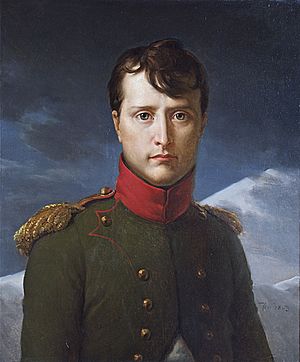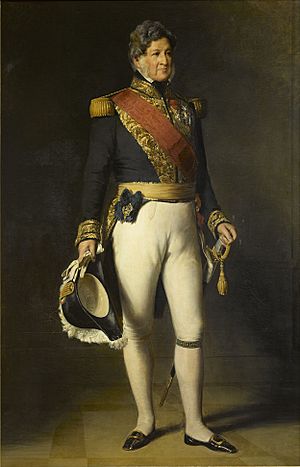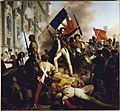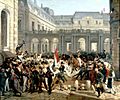July Revolution facts for kids
- This article is about the French Revolution of 1830. The better known French Revolution started in 1789.
| Part of Bourbon Restoration | |
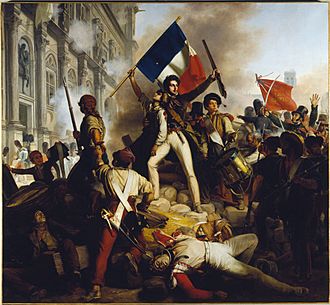
Battle outside the Hôtel de Ville, by Jean Victor Schnetz: an allegorical painting of the July Revolution.
|
|
| Date | 26–29 July 1830 |
|---|---|
| Location | France |
| Also known as | The July Revolution |
| Participants | French society |
| Outcome | Abdication of Charles X Ascension of Louis Philippe to the French throne and establishment of the constitutional July Monarchy |
The French Revolution of 1830, also known as the July Revolution, was the throwing off of Charles X of France from power. His cousin Louis-Philippe, the Duc d'Orléans became king. However, after 18 hard years on the throne, he, also, would be taken off the position of king. It showed the change from one kind of monarchy to another. This change was from the Bourbon Restoration to the July Monarchy. This also marked the change of power from the House of Bourbon to the House of Orléans. People who supported Bourbon would be called Legitimists. Supporters of Louis-Phillipe were called Orleanists. Louis-Philippe was king of the French (not King of France) until the French Revolution of 1848.
Contents
Background
On September 16, 1824, Charles X came to the throne of France. He was the younger brother of Louis XVIII. When Napoléon Bonaparte was defeated, he had become King of France. Both Louis and Charles ruled because of their birth, not because a great number of people wanted them to. This was the first of two things that began Les Trois Glorieuses, the "Three Glorious Days" of the July Revolution.
When Napoleon abdicated in 1814, Europe, and mostly France, was in great confusion. The Congress of Vienna met to draw the continent's political map again. A great number of European countries came to the congress. However, there were four most important powers that controlled the decision. These powers were the United Kingdom, Austria, Russia, and Prussia, represented by King Frederick William III. Another very important person at the Congress was Charles Maurice de Talleyrand. He was a French diplomat under Napoleon. France was considered an enemy state.
Talleyrand suggested that Europe go back to its first, "legitimate" government. He meant the government before Napoleon. This plan was largely accepted by members of the Congress. France went back to its 1789 borders and the House of Bourbon came back to the throne. In the eyes of the Congress, the political situation in France and Europe was now back to normal. However, the new king, Louis XVIII, felt that ideas of nationalism and democracy were still in his country. So, they made and signed the Charte constitutionnelle française, the French Constitution. It is also known as La Charte. This was the second action that began the July Revolution.
Result
The revolution of July 1830 created a constitutional monarchy. On 2 August, Charles X and his son the Dauphin abdicated their rights to the throne and departed for Great Britain. Although Charles had intended that his grandson, the Duke of Bordeaux, would take the throne as Henry V, the politicians who composed the provisional government instead placed on the throne a distant cousin, Louis Philippe of the House of Orléans, who agreed to rule as a constitutional monarch. This period became known as the July Monarchy.
The July Column, located on Place de la Bastille, commemorates the events of the Three Glorious Days.
This renewed French Revolution sparked an August uprising in Brussels and the Southern Provinces of the United Kingdom of the Netherlands, leading to separation and the establishment of the Kingdom of Belgium. The example of the July Revolution also inspired unsuccessful revolutions in Italy and the November Uprising in Poland .
Two years later, Parisian students, disillusioned by the outcome and underlying motives of the uprising, revolted in an event known as the June Rebellion. Although the insurrection was crushed within less than a week, the July Monarchy remained doubtfully popular, disliked for different reasons by both Right and Left, and was eventually overthrown in 1848.
Images for kids
-
Charles X in coronation robes, by Robert Lefèvre
-
Scenes of July 1830, a painting by Léon Cogniet alluding to the July revolution of 1830
-
The arrival of the duc d'Orléans (Louis Phillipe) at the Palais-Royal, by Jean-Baptiste Carbillet
-
Louis-Phillipe going from the Palais Royal to the Hôtel de Ville, 31 July 1830, by Horace Vernet
-
Eugène Lepoittevin, Souvenirs patriotiques no. 2, 1830, Bibliothèque nationale de France
See also
 In Spanish: Revolución de 1830 para niños
In Spanish: Revolución de 1830 para niños


